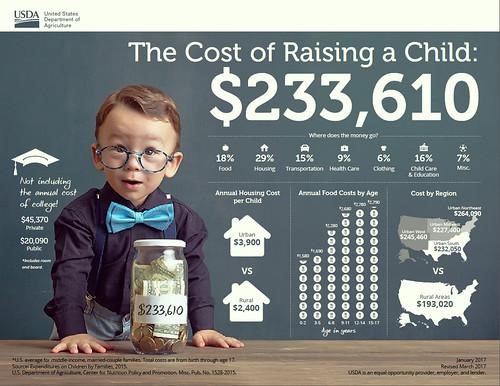In 2015, the U.S. Department of Agriculture (USDA) calculated that, for a middle-income ($59,200 to $107,400), married couple the cost of raising a child to their 18th birthday was $233,610, or $12,978 a year. Adjusted for inflation, that’s a total cost of $267,400.58, or $14,855.21 a year. This figure obviously does not include the cost of college education. Where does this money go? The USDA’s Expenditures on Children by Families, 2015 report found that 29% of this cost goes to housing, 18% to food, and 16% to child/care/education. The cost of child rearing tends to increase as a child gets older. For parents, costs of child rearing are not the first thing that they think about when they get married. However, as the report’s findings show, these costs are large, grow every year, and can easily lead to financial difficulties for parents. Budgeting for a baby is very important if parents are to balance providing for their children with remaining in good financial health.
Source: Expenditures on Children by Families, 2015
Frame Your Costs
The costs of child-rearing depend on the household income of the family. For example, a family with a pre-tax income of $59,200 or less, spends between $9,330 and $9,980 a year, compared to households with a pre-tax income of over $107,400, who spend between $19,380 and $23,380 a year. The first lesson is that you should adjust your planned costs to what your income level can tolerate.
When planning your budget, it’s important to have the right decision making framework. Use a decision tree to go through various possible scenarios, so that you have a robust plan.
Your budget should consider both once-off costs that you will assume in order to have the baby, such as prenatal care and the delivery, and the month-to-month costs of child-rearing, such as for bottles, clothes, creams, diapers, food, formula, and toys. Check for the costs of these items at a baby store. In addition, you should probably multiply the current price by 1.5 to account for inflation as well as to give yourself a buffer for any things that you will not have thought of.You should also start making contributions into a 529 college savings plan, which is tax-deductible at the state-level. Over 18 years, those contributions can add up to a substantial amount.
Decision trees will make it easier to foresee and plan for crises, such as the baby getting sick and needing to see a doctor. One cost that you need to have is for an emergency account. Fund this account to prepare for the emergencies that your decision making process suggests can happen. Being a parent is wonderful, but it does come with challenges, and you need to plan in advance for them.
Use Any Help You Can Get
They say “it takes a village to raise a child”. This is because no two parents can ever possibly give a child everything that child needs. Work with your network of friends and family to help you with raising your child. You will need all of them. Take advantage of schemes such as child tax credit. The American Rescue Plan increased it from $2,000 to $3,600 for qualifying children under 6, and $3,000 for other qualifying children under 18. The full child tax credit is available for households with incomes of $150,000 or less.

